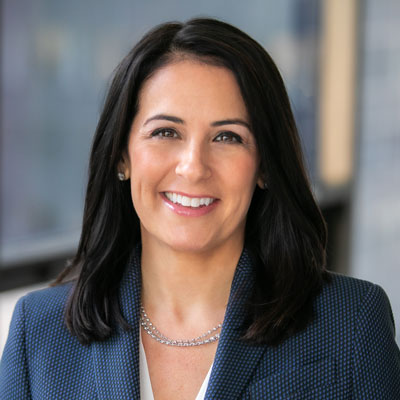With modest leverage and a conservative, diverse capital structure focused on unsecured bonds, Ladder Capital Corp (NYSE: LADR) believes it is in an advantageous position to navigate the current economic uncertainty.
Ladder’s investment objective is focused on preserving and protecting shareholder capital while producing attractive risk-adjusted returns.
The New York-based company invests in loans, real estate, and investment-grade securities, specializing in underwriting commercial real estate and offering flexible capital solutions within a sophisticated platform. Ladder focuses on granularity and diversity, and that’s reflected in a $25 million average loan size.
“We’re modestly levered at 1.9 times adjusted debt-to-equity, and we have a really differentiated composition of leverage; it’s not just lightly levered, it’s done in a thoughtful way with a termed-out structure anchored by unsecured bonds, which is unique in the commercial mREIT space particularly,” says Pamela McCormack, a founder and president of Ladder Capital. “That leaves us with about 50% ($3 billion) of assets unencumbered.”
Birth of a REIT
Ladder was formed in 2008 to invest across the capital stack and held its IPO in 2014.
“It’s essentially the same business plan today as it was when we opened the doors,” says Brian Harris, a founder and CEO of Ladder. “We have the same priorities today as the first day—principal preservation first and maximizing a safe return on equity with conservative leverage.
When Ladder commenced operations in October 2008, a time of financial crisis, AAA CMBS bonds were trading at 90 cents on the dollar. So, Ladder immediately pivoted—rather than write loans to securitize, the company began to buy securities, which turned out to be a fortuitous pivot. “When the world got back on its feet, the government’s Term Asset‐Backed Securities Loan Facility (TALF) program ended, and then we began to securitize loans,” Harris says.
Harris, who served as head of global commercial real estate at Dillon Read Capital Management before starting Ladder, explains that the company deliberately chose to stay focused, avoid too much leverage, and to stay away from matching long-term assets with short term liabilities.
“When we started Ladder, we decided to set it up in a way that would try to avoid these pitfalls, which tend to be problematic for companies in very difficult periods of the economic downturn,” Harris says.
Ladder has a middle-market focus, and it’s internally managed with high insider ownership—the board and management own more than 10% of the company.
Harris touts the mREIT’s access to the unsecured corporate bond market. “We have $1.6 billion of corporate debt outstanding and it’s not due on average for about five years, so we really don’t have a threat coming in the near term, and that’s a very safe place to be living,” Harris says.
A newer priority since the early days is that Ladder is looking to become an investment-grade company and believes it is well on the path to achieving this.
“We really feel there’s a need for a safe and conservative dividend with a high-single or low-double-digit return in this environment,” McCormack says.
Investment Activity
Over the past 15 years, Ladder has made more than $45 billion of investments, including $30 billion of loan originations in over 475 cities across 48 states, with an average loan size of approximately $25 million. As of the end of 2022, Ladder had approximately $6 billion in assets.
The company’s portfolio consists of a diverse array of assets, with a focus on senior secured assets. The company’s investment activities are spread between its primary business of originating senior first mortgage fixed and floating rate loans collateralized by commercial real estate with flexible loan structures; owning and operating commercial real estate, including net leased commercial properties; and investing in investment-grade securities secured by first mortgage loans on commercial real estate.
When looking at geography, Harris says it’s not unusual to have concentrations in densely populated areas, because that’s where commercial real estate tends to thrive. However, often those types of assets in big cities become overbid.
“Today, for instance, we have very little exposure in San Francisco. It’s not that we don’t like San Francisco, we just felt it was too expensive given the risks we would be taking. We don’t believe in bad assets, just bad prices,” Harris says.
Ladder also focuses on safety in the principal column more than it does on spreads, taking existential risks off the table almost immediately.
“The way we do this is through deep diversification and through smaller loans,” Harris says. “We lend a lot in the Midwest, we have quite a few loans in Ohio. We like Denver and Phoenix; we tend to avoid the coasts but not exclusively. Right now, the big cities that are having problems, they are going to become opportunities.”
The Triangle Philosophy
Ladder has an investment strategy that can be broken up into the three points of a triangle—loans, securities, and real estate.
“They are all variations on the same product; they have different levels of liquidity, but they are all pretty much dependent on the value of real estate and the cash flows, and how sustainable they are,” Harris says. “We created a company where we have the ability with permanent capital to move around as we see fit.”
For instance, when the company opened its doors, the conduit business became a profitable part of the equation, generating more than $150 million in one year.
Yet, if one looks at Ladder’s balance sheet today, one might think the mREIT isn’t in the conduit business at all, but that has always been a part of its three-pronged plan.
“We express these interests and preferences at times as things get cheaper or more expensive, and I believe by next year, we will look like we’re in the conduit business,” Harris says. “Spreads are beginning to tighten, though you have to balance that with a Federal Reserve that’s selling $50 billion a month in mortgages. But there’s no supply at all.”
Ladder doesn’t have a preference for which of its three points it is focusing on at any given time but tries to allocate capital to the safest and highest return among these three themes. The past couple of years, it has turned more attention to bridge loans, but that changes every few years.
Notable Deals
One of Ladder’s earliest deals was acquiring the Veer Towers, an iconic condo community in Las Vegas, despite Harris saying a few years earlier that the company would not be lending on condos in New York or Las Vegas.
“Prices had come down and we were able to buy them at a very effective price, and we made a lot of money on that,” he says. “It’s a reminder that while we are a lender first, we’re happy to occasionally explore equity investments if we think there’s a good opportunity.”
Another noteworthy deal seven years ago was Ladder’s $124 million acquisition of five office buildings in Jacksonville, Florida, all triple-net leased to Bank of America. BofA announced it was spending $150 million on its space to improve the property, while building a $20 million garage to improve parking.
More recently, Ladder provided a $250 million floating rate bridge loan on a high-rise office building in downtown Miami to the new owner of Citigroup Center. Ladder also provided a $113 million three-year floating rate bridge loan to an Atlanta investor to finance the acquisition of Aventura Corporate Center, a Class A office park in Aventura, Florida.
“We focus on transactions that we feel comfortable with and we’re not at all jumpy about getting into a $100 million trade, but in general we go for deals around $25 million,” Harris says.
Growth Prospects Ahead
In January 2020, Ladder raised $750 million in unsecured corporate debt at a rate of 4.25%, so it had a large amount of liquidity at an important time.
“As an outcome of that scenario, today, 7% of our loans are due in 2023 and 80% of our loan inventory was originated after March 2021, a full year after the start of the pandemic,” Harris says.”
The company’s growth prospects come from its balance sheet, with Harris explaining that Ladder has the ability to add another $1 billion to $2 billion dollars.
Matthew Howlett, senior research analyst at B. Riley Securities, believes Ladder’s differentiated approach is what makes the company’s outlook so positive.
“They were built upon this sort of externally managed, self-advised REIT structure with significant inside ownership, so they’ve always had the touch of ‘eating their own cooking,’ and have organically created loans for investment and always had a rigorous underwriting process,” he says. “They have focused on the middle market side.”
Howlett feels Ladder’s outlook is superior to most of its peers because of its balance sheet and the way it is financed.
“As the cycle shifted with interest rates moving higher, Ladder had the luxury of having fixed-rate term financing in place. They are benefiting from the rise of interest rates because nearly 100% of their investment portfolio is floating rate,” Howlett says.
With about half of its 65 employees dedicated to origination and underwriting, the team covers the entire United States, and the company continues to grow and deliver on its founding mission.
“In the end, a conservatively levered company that delivers a low double-digit return with the managers fully aligned with the equity side-by-side is a very strong fact that resonates with our investors,” Harris says.
“We have a deep understanding of the economy with a group of people who have worked together for decades and have an extensive history of generating attractive returns while avoiding major problems through all sorts of cycles and downturns. We’re looking forward to what lies ahead for Ladder,” he adds.

